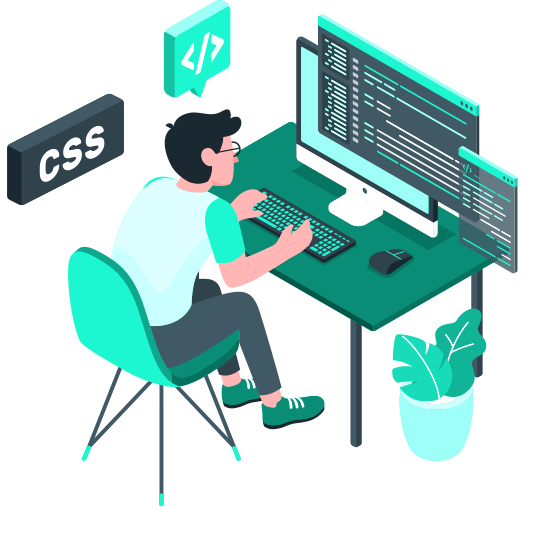Cascading Style Sheets, fondly mentioned as CSS, maybe a simple design language intended to simplify the method of creating sites presentable.
CSS handles the planning and feel of a neighbourhood of an online page. Using CSS, you can control the fonts, the spacing, column size, background images or colours that are used, layout designs, variations in display for various devices and screen sizes also as a spread of other effects.
CSS is straightforward to find out and understand but it provides powerful control over the presentation of an HTML document. CSS is a combination of HTML or XHTML markup languages.
Advantages of CSS
CSS saves time − you’ll write CSS once then reuse the same sheet in multiple HTML pages. You can define a method for every HTML element and apply it to as many sites as you would like.
Pages load faster − If you’re using CSS, you are not going to write HTML tag attributes whenever. Just write one CSS rule of a tag and apply it to all or any the occurrences of that tag. So less code means faster download times.
Easy maintenance − to form a worldwide change, simply change the design, and every one element altogether the online pages are going to be updated automatically.
Superior styles to HTML − CSS features a much wider array of attributes than HTML, so you’ll provide a much better look to your HTML page as compared to HTML attributes.
Multiple Device Compatibility − Style sheets allow content to be optimized for quite one sort of device. By using an equivalent HTML document, different versions of an internet site are often presented for handheld devices like PDAs and cell phones or printing.
Global web standards − Now HTML attributes are being deprecated and it’s being recommended to use CSS. So it’s an honest idea to start out using CSS altogether the HTML pages to form them compatible with future browsers.
Top 5 CSS tools one must use
There’s a custom tool for pretty much everything these days. From free web apps to more premium tools, you can find a lot online if you just search.
If you need something to speed up your workflow, I’d bet someone else had that same need and already created a tool for it.
This is especially true for developers who know how to build web apps and launch them online. The entire web is suffering from handy tools tailored for a faster dev workflow.
In this guide, I would like to focus specifically on CSS tools for web developers. These tools all run in your browser and can help with a handful of laborious tasks during your day-to-day project work.
CSS Lint
CSS Lint will mean syntax errors also as highlight potential problems associated with browser compatibility, performance, accessibility, and other areas of concern.
The ASCII text file of CSS Lint is out there on GitHub just in case you would like to run it offline on your computer or web server.
Use for: Identifying issues that are not common through visual testing and CSS validation.
CSS Stats
CSS Stats, just as its name suggests, provides you with a plethora of stats about a site’s CSS such as how many styles rule the website has, the media queries it uses, all the fonts it employs and more.
Use for: Getting insights a few website’s CSS for analysis and for locating potential improvement points
CSS Shrink
CSS Shrink is a web tool for reducing the file size of your CSS, which translates to page-load-time improvements. Removes unwanted objects like spaces, comments, newlines, and tabs.
Minifying your ASCII text file makes it hard to read, so this could only be done after development, and you ought to still have a non-minified CSS ASCII text file for future development and maintenance.
Use for: Speeding up your website
ProCSSor
This clean, format, and organize your CSS online. What’s great about this CSS-formatting tool especially is that it’s a lot of configuration options so that you’ll have great control over how your code is formatted.
Other CSS code-formatting tools to see out are CSScomb, Code Beautifier, and Styleneat.
Use for: Quick format and clean up
Codrops CSS Reference
This useful CSS reference developed by Codrops are often used as a tool for learning about certain CSS properties, pseudo-classes, functions, etc.
Use for: Learning and discovering unfamiliar CSS features
Bonus: Developer Tools That Come with Your Browser
Perhaps the foremost important CSS development tool is that the one that you simply probably already have: Chrome has DevTools, Firefox features a set of built-in developer tools accessible through the browser’s menu, also because the Firefox Developer Edition, Safari has Web Inspector and IE has F12 Developer Tools.
These developer tools aren’t strictly online tools just like the others mentioned during this list because they’re going to work even without an online connection, but they’re tools that you simply should be using during CSS development.
In-browser dev tools are full of features for debugging, analyzing and profiling your CSS.
Chrome DevTools — my favourite of the bunch — can, for instance, profile your CSS to help you spot performance issues about slow paint times and rendering times.
Use for: Debugging, analyzing and profiling your CSS
That’s it!
Now that we’ve reached the end of this list I hope that you’ve picked up one or two tools that could make your life a little bit easier.

